This is part two of Sir Longballs. If you haven't read part one, you can find it here.
For many of us, just the thought of a doctor’s visit—a regular, standard-operating- procedure checkup—is an anxiety-provoking way to ruin the week leading up to the appointment. When you are sure that the visit will involve a frank discussion of your reproductive organs and the act of pulling down your pants, that anxiety turns to pure, 100-proof dread. True to form, I wasn’t at my best leading up to the appointment. Not only was the embarrassment of the visit bumming me out, but lurking behind that bogyman was the real fear—the thought of what might come out of the doctor’s mouth regarding my condition.
He breezed into the examining room with that unbothered combination of busy and friendly so many doctors have perfected. We shook hands, and he picked up the tablet in the room and began reading about me as I stood there dumbly, waiting for him to ask me a question or to issue a command—stick out your tongue, turn your head and cough, drop your trousers.
“So,” he said, “What’s up? What’s going on with you? How can I help?”
“Well,” I said, “I’m just going to be direct because I can’t think of any other way to say it: My testicles are huge, doc. I think something is really wrong.” I exhaled. I felt woozy but better for finally confiding in someone who’d gone to medical school.
“Gotcha. How long have you noticed this problem?”
I began explaining. Telling him the whole story, using only the word testicles.
“Well,” he said, “a picture’s worth a thousand words. Let’s take a look.”
Is it crazy to admit that I’d picked out my best, newest pair of underpants because I knew this moment was coming? I did. If the doctor noticed, he didn’t say anything. Instead, he got to work with the examination. I turned my head and looked away.
“Okay,” he said, snapping off his blue latex gloves, “That’s it. That’s all.”
I hiked my pants back up, buttoned my trousers, and exhaled.
“What you have—I’m 99 percent certain—is called a hydrocele. It’s not serious. I see them all the time.” He explained the condition to me. Typically, the testicles are surrounded by a smooth, protective internal sac. You can’t feel it. You don’t even know it’s there. Its only job is to produce a small amount of lubricating fluid to allow the testes to move freely. If there’s any excess fluid in this sheath, it is supposed to drain away via the veins in your scrotum. If that process stops working and the fluid begins to accumulate, that’s a hydrocele. The doctor assured me that I would not die, and sent me off with an appointment to see a urologist to take care of the problem.
“That thing is dead,” said Murphy, “D-E-A-D dead. That’s the deadest tooth I’ve ever seen. I’m surprised it’s still hanging in there.” He poked at it with the probe. “It looks like it’s a little bit infected, but the nerve is just shot. It’s gone. Damn. It’ll probably fall out on its own, or if you want, I can pull it out right here. It probably won’t even hurt that much.”
This bulletin was too much for the crowd. They erupted in wild hoots and started yelling at Murphy—to pull that tooth, pull that tooth! Pull! That! Tooth!
“Hold on a minute, man,” I said. “That’s demented. Are you seriously telling me you want to pull a tooth out of my skull in the Bitterroot Flat Campground in the middle of nowhere? What are you going to use, 20-pound test and a pair of fishing pliers? How am I supposed to fish tomorrow with a molar-sized hole in my head?”
I didn’t have testicular cancer. I wasn’t scheduled to die (yet). I felt great, even though I was pulling open the door to an office with the word “Urologist” screen-printed on it. I did the usual stuff—height, weight, blood pressure— and, within a few moments, the urologist appeared. He was an older guy. I imagined how many pairs of balls he’d seen in his career—thousands, I’m sure. It wasn’t that I thought seeing so many people’s privates was odd or strange or anything. It’s just that, well . . . that’s a lot of testicles and a lot of variety.
I couldn’t help but recall a Saturday-afternoon assignment I’d volunteered for as a reporter in Boise, Idaho. The idea behind a “Testicle Festival” was to herd hundreds of folks into the local rodeo grounds, lubricate ‘em with beer, spray ‘em with country music, and then feed ‘em what they called “Rocky Mountain oysters,” “swinging beef,” “sack lunch,” “tendergroin,” or any of a dozen other nicknames for breaded and deep-fried bull testes.
On the day of the festival, I arrived at the fairgrounds before the crowds. I watched a small assembly line of Stetson-wearing men and women slice open the membrane surrounding nut meat and remove the potato-sized testicles. They discarded the membrane and sliced the “bull’s eggs” into coins about ¼-inch thick. Those membranes—that was my problem right there. For both the bulls and me, the membranes—and what they held—had led to nothing but trouble.
The “cowboy canapés” were seasoned, breaded, dunked into hot oil, and sold to patrons for ten bucks a portion. The nutsteaks were a hit. Everyone was laughing, teasing one another, egging each other on. They made faces when they ate them, but they couldn’t get enough. They’d say, “Ya know, they’re not too bad!” and slap each other on the back.
I thought the Rocky Mountain oysters were unremarkable. They didn’t taste like anything but the mayo/ketchup dipping sauce and the old fryer grease. But it was the texture that got me. They were like a cross between a boiled hot dog and a sautéed sponge. Bleh.
“Well,” said the urologist, “I can tell you that’s definitely a hydrocele—and it’s a doozy, my friend. A world-class specimen. Let’s get this taken care of.”
“Look,” Murphy said, “this thing is not going to get better on its own. The nerves are gone. The tooth is rotten. It ain’t comin’ back.” Everyone leaned in, listening intently, like young dental students at their first tooth-pulling lesson. And after what was pretty much a perfect day of fall fishing on Rock Creek, this was the finest après angling entertainment ever—for everyone but me.
“Here are your options, as far as I see them,” said the alleged dentist. “Number one: You can leave it in there. It will continue to hurt. The infection could get worse, and you could be in a lot more pain. Number two: you could go back into Missoula, find a dentist who might see you, and have him pull it. Or, number three: I could yank it right here in about five minutes.” The crowd—most still in their waders—hooted, as before, “Pull that tooth! Pull that tooth!”
The procedure to treat a hydrocele is simple. A local anesthetic is injected into the scrotum, and, after everything is good and numb, a syringe is inserted to drain the accumulated fluid. Sounds simple. It should be easy. Foolproof. A slam dunk.
It didn’t take. After a few weeks, the hydrocele had returned as plump, bull-like, and robust as ever. I went in again for another procedure. “It’ll work this time. I’m almost sure of it,” said the doc. “I’ve done thousands of these.”
“What if it doesn’t?”
“Then we go to plan B.”
After a month, the hydrocele returned. I had to face whatever Plan B had in store for me.
Plan B, the doctor said, was the knife. I had no choice. I was scheduled for surgery—the dreaded hydrocelectomy, aka the “Western Snip, Stitch, and Tug” repair. It sounds like instructions on how to tie a salmon fly. The procedure has an excellent success rate and promises reduced pain, inflammation, infection, and discomfort for the patient.
Here’s how it’s done: A two- to three-centimeter incision is made into the scrotum over the spermatic cord. The cord is lifted through the wound and gentle pressure on the scrotum is used to manipulate the hydrocele sac so that it’s visible in the incision. The sac is punctured, and the hydrocele fluid is drained. The sac is turned outward, bringing the free edges behind the spermatic cord and testes. These edges are then fixed in place with a single figure-of-eight suture. Gentle traction on the scrotum pulls the testes back into position. To finish, tissue and skin are closed via absorbable sutures. In my case, a small tube was inserted into the incision to continue draining the area after the surgery.
This is not a good time.
I crawled up from under the anesthetic dazed, confused, and in exquisite pain. The fluorescent lights were harsh, the smells were acrid and sharp, there were strangers everywhere, and my groin was packed and wrapped like a pharoah from Egypt’s great tombs.
The recovery was excruciating, awkward, and honestly really scary. Fortunately, my partner was around to lighten my mood with her silly testicular puns, gentle teasing and encouragement. In about a week or so, I was back on my feet, walking around in pants that fit a bit more comfortably. I was grateful to be healthy again.
But after a couple of months, I noticed something again wasn’t quite right. The cursed hydrocele was back—again. It was unthinkable. My doctor said it was against all odds. I was scheduled for another surgery. It was fall. In my neighborhood, near the beach of Puget Sound, salmon were running. I couldn’t fish. I couldn’t even think about the future.
“What about aftercare,” I pleaded to Murphy. “What happens after you pull that tooth? Do I just swish my mouth out with some Maker’s Mark, hop on my horse, and ride off into the sunset? What the fuck, dude? What about an infection? What about dry socket? I’ve heard of that, and it really doesn’t sound cool!”
“Well, you’re right,” he said. “You don’t want dry socket. But we can pack some gauze into the hole, and you should be fine. From the looks of that sucker, it probably won’t even bleed that much.”
“Look,” I said, “we’ve only got four or five more days here. I’ll be fine after a couple beers, okay? I don’t feel like bleeding out on the banks of Rock Creek.”
“What are you so afraid of? If you can give us one good reason why we shouldn’t pull that tooth right here, right now, I’ll leave you alone.” It was the decisive moment.
The second time under the knife was even worse than the first. Everything hurt more. The recovery was more painful and took longer. My mood was crabbier. But slowly, my wounds healed and my attitude improved, just in time for the annual trip to Rock Creek with the fellas.
One of the traditions on this trip is that everyone has a night when they are responsible for making dinner for the rest of the crew. It’s a serious task, and everyone brings their A game. The feasting is epic. We’ve had everything from ribeye to walleye fry-ups, all manner of T-bones, tenderloins, birria tacos, venison chili, and smoked BBQ brisket. It’s awesome.
My plan was simple: balls. I’d start by unraveling the hydrocele story while I prepped the kitchen and made cocktails for the gang. I’d cook while I told the story—the needles, the sutures, the operation, every bloody detail. Then I’d fire up the appetizer. Set up a sauté pan with some olive oil on medium heat. I’d open the vac-sealed pouch and slide the already-breaded portions into the oil. Just as my tale reached a crescendo, they’d be done: a steaming- hot plate of Rocky Mountain oysters with authentic dipping sauce. Bon appétit!
“All right. Fuck it. Let’s do it.”
Murphy pumped his fist and said, “Yes!” The crowd cheered and got their cameras ready. He dug through the small Dopp kit that had produced the probe and mirror. “I always carry a few tools with me,” he said. In case of ... well, this.” He held up a medieval-looking pair of pliers for all to see. “These, gentlemen, are extraction forceps. German made. Stainless steel. Matte finish. Quite ergonomic.”
A roll of paper towels had appeared. Some ice was scooped out of the cooler. Murphy was snapping on rubber gloves and unwrapping a roll of gauze.
“Let’s do this,” he said.
I took a swig of the whisky. I needed it. I made the sign of the cross. I was being dramatic. I reclined into the chair. Everyone gathered around. Everyone clicked their headlamps to blazing. “I forgot I even had this lidocaine in here. You’re in luck. Open up,” Murphy said. He stuck his finger in my mouth and rubbed it on my gums.
“Yep,” I heard him say. “There she blows.” He let everyone step up and get a good look. “Okay . . . hold on. I’m gonna count to three.”
One . . . the crowd howled the number along with him.
And then he pulled the tooth. He didn’t count to three. He yanked it on “one” and the tooth popped out easily. He was right. It was over before it began. It didn’t even hurt.
“There it is!” he shouted. Everyone was stunned, then everyone hollered, “Hooray!” Everyone wanted to see it, but no one wanted to hold it. It looked as nasty in my palm as it felt in my mouth. Dirty yellow and mottled brown with jagged roots. “That’s it. That’s the whole thing—roots and all,” he said. “Came out in one piece, too.”
I gingerly pushed my tongue over. I tasted blood and probed the hole. I spit red. Murphy handed me a wad of gauze. “Here,” he said. “Get this in there. Don’t fuck with it for awhile.”
Everyone was looking at me, but the drama was over. I was fine. I wrapped the poop tooth in a paper towel and put it in my pocket. I sat back down to catch my breath, glad to be feeling reasonably okay.
Finally, after a round of fresh beers had been cracked, I’d been congratulated for my bravery, Murphy had been praised for his technique, and the whole ordeal retold once or twice, someone finally asked, “Who’s turn is it to cook tonight?”
Sir Longballs is excerpted from River Songs: Moments of Wild Wonder in Fly Fishing (August 2024), published by Mountaineers Books.










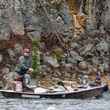








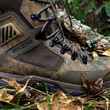
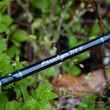








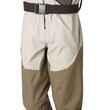
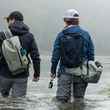
Comments
Jon Tobey replied on Permalink
After launching so many other authors' careers, it's about time Duda joined the canon if ff literature with this little gem of a book. I bought 2 copies.
Pages